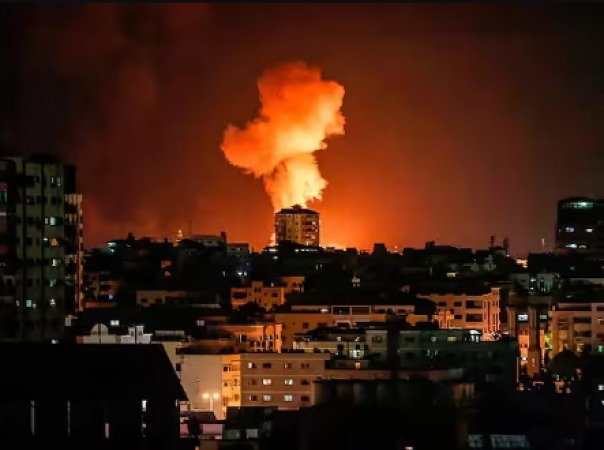
USA: Following the announcement that a contractor had died in a drone strike, US President Joe Biden last month ordered airstrikes on several targets in northeastern Syria.
The Syrian Arab Army (SAA) and its militia allies then launched an unprecedented response, shelling US positions all day the next day. An important turning point in the conflict between the two sides can be seen in this exchange of fire.
A drone of Iranian origin allegedly struck US forces stationed close to al-Hasakah in northeastern Syria on March 23, killing an American contractor and injuring a number of service members, according to a statement from the US Department of Defense. Then, F-15 fighter jets were launched from Doha to strike militias supported by Iran in the Syrian province of Deir ez-Zor.
Also Read: This summer NATO intends to hold its largest-ever Air Force exercises
In the east of Syria, there have recently been a number of exchanges between militia groups allied with the US and Iran. Even so, there were very few American casualties from these, and the brief escalation was kept under control.
What changed after the US airstrikes on March 24 was that there was intense retaliation from both the SAA and Iranian-aligned militias in Deir ez-Zor. Six US soldiers suffered traumatic brain injuries as a result of the response, which primarily targeted American forces near the al-Omar oil fields and hit several US bases.
The next day, when asked about retaliating against Iran for the exchange in Syria, Joe Biden said the US was "not going to stop" during a visit to Canada. He said, "Be ready for us to act firmly to protect our people.
Later, it was revealed that the USS George H.W. Bush, one of the Biden administration's aircraft carriers, had been positioned closer to Syria. According to Deputy Pentagon Press Secretary Sabrina Singh, this was because of "increased attacks from [Iran's Islamic Revolutionary Guard Corps IRGC-affiliated groups targeting our service members across Syria."
Also Read: attempt to grab school land under AAP rule! Congress leader Sanjay Talwar wrote a letter
What this signifies is a strategic shift in the equation put forth by Syria and its allies in the east of Syria, regardless of the future actions the US may take. This, according to a reliable Iraqi source with firsthand knowledge of the events, was "an order to now kill American troops and not just fire warning shots."
The escalation in the northeast is directly related to ongoing Israeli aggression against the country, according to a Syrian political source who requested anonymity for security reasons:
"The recent action by Syria and its allies is a direct reaction to an uptick in Israeli aggression against the nation that started last year. If you recall, there was a similar standoff between American forces and IRGC allies in northeastern Syria in August of 2022. The United States has previously discussed the significance of its military presence in Syria for Israel's war-between-wars campaign against Iran-aligned forces there, which has directly contributed to the Israeli escalation.
One of Tel Aviv's inter-war campaigns is the "war between wars," in which clandestine operations are carried out against adversaries while tensions between the two sides are relatively low. In the most recent campaign, Israel has primarily targeted Iranian-linked targets both inside and outside of Iran. It has also carried out a significant number of unannounced airstrikes inside Syria, where members of the IRGC as well as allied militia groups have been targeted. Although it is standard practise for the Israel Defense Forces to remain silent regarding such attacks, Prime Minister Benjamin Netanyahu has previously acknowledged that "hundreds" of them have occurred over the years.
Washington will only have two options if Damascus continues to use its new strategy of violently retaliating against the US military in northeastern Syria: engage in negotiations with Damascus or depart the country. The pressure of continuing the occupation inside a nation that neither the US public nor Congress were consulted about could weigh heavily on the Biden administration if American soldiers are returning in body bags. This is especially true now that Washington's NATO ally Turkey and Damascus' formal relations are beginning to normalise in the Arab world.
As both nations may end up cooperating during any future Turkish offensive against the Kurdish-led Syrian Democratic Forces (SDF) in the northeast, a Syria-Turkey détente may be necessary to drive the US out of Syria as well.
Also Read: Husband Fahadh wishes Swara Bhaskar on her birthday
The SDF functions as a sort of US proxy force, enabling the Americans to occupy roughly one-third of Syria's territory with only a small contingent of their own soldiers, including the majority of its natural resources and the most productive agricultural lands. In order to avoid unintentionally upsetting their NATO ally, the US withdrew its forces after Ankara's previous attacks in 2018 and 2019.
Theoretically, Syria could be prepared to retake its oil fields in the event that Turkey launches another military operation.
Assuming the Biden administration is not wholly committed to staying, the adoption of a direct confrontation strategy by Iran-aligned groups and the Syrian government could open up new vistas and raise the prospect of a US withdrawal.